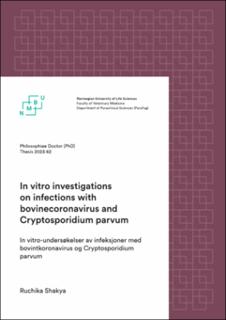| dc.description.abstract | Intestinal infection causing diarrhoea is a major health problem among calves accounting for about 40% of calf diseases in Norway. Calves are especially susceptible to gastroenteritis during the first month of life of which bovine coronavirus (BCoV) and the intracellular parasite Cryptosporidium parvum (C. parvum) are the two major enteropathogens involved. Several studies have indicated that mixed infections are more common among diarrhoeal calves and that co-infections are associated with greater symptom severity. However, the pathogen-pathogen interplay and host-pathogen interaction during co-infection are unknown. Therefore, the overall objective of this thesis was to study the interplay between BCoV and C. parvum during infection and their possible effects on the host using in vitro models.
To study the BCoV and C. parvum interactions during infection, human HCT-8 cells were sequentially and simultaneously inoculated with the two pathogens. Quantitative results from (RT)-qPCR revealed prior inoculation of cells with one pathogen did not have any effect on replication of the other. Co-inoculation, however, showed an interesting result indicating binding of BCoV to C. parvum sporozoites. There was an increase in viral RNA in presence of sporozoites at 1 hpi (hours post inoculation) which was no longer evident at 24 hpi indicating entrapment of virus in the parasitophorous vacuole. To test whether the attachment between BCoV and C. parvum sporozoites could be specific, bovine norovirus (naked) and equine herpes virus-1 (enveloped), were included in the study. The results indicated no binding between sporozoites and these viruses, which strengthens our assumption that binding of BCoV to the sporozoites is specific. Furthermore, flow cytometry to study the proportion of single and co-infected cells at 72 hpi showed that C. parvum and BCoV infected 1-11% and 10-20% of the HCT-8 cells, respectively, with only 0.04% of double infected cells.
The host response was investigated with RNASeq of HCT-8 cells inoculated with BCoV alone, C. parvum alone, and BCoV/C. parvum simultaneously. There were more than 6000 differentially expressed genes (DEGs) in BCoV- and co-infected cells while only 52 DEGs were found for C. parvum infection at 72 hpi. Pathway (KEGG) and gene ontology (GO) analysis of BCoV- and co-infected cells revealed involvement of mostly immune related pathways (NF-κB, TNF or, IL-17), apoptosis, and regulation of transcription while limited effect was exerted by C. parvum under our experimental settings. The most enriched GO terms from C. parvum-infected cells at 24 hpi belonged to metabolic categories but at 72 hpi additional GO terms, such as cell death and responses to oxygen-containing compounds, occurred. Despite the modulation observed in the co-infection being dominated by the virus, which was probably due to differences in the infection rate of the pathogens, over 800 DEGs were exclusively expressed in co-infected cells at 72 hpi. Our findings provide insights on possible biomarkers associated with co-infection, which could be further explored in vivo.
Furthermore, a 3D bovine enteroid model (complex model due to heterogenous cell population) was established as a replication system for BCoV. Immunostaining showed that the enteroids had a differentiated cell population. RT-qPCR results of the infected enteroids showed seven-fold increase in BCoV RNA at 72 hpi. The BCoV S-protein was detected by immunostaining, which indicates that virus particles might be produced. The expression of selected genes during BCoV infection of the enteroids was compared with the expression we previously found in HCT-8 cells. The pro-inflammatory responses of the enteroids such as IL-8 and IL-1A were comparable in the two models, while the expression of CXCL-3, MMP13, and TNF-α was significantly downregulated in the enteroids.
In conclusion, there was a limited impact of co-infections on replication of the two agents, but upon co-inoculation we found binding of BCoV to the sporozoites which inhibited viral replication. The host transcriptome study revealed that some of the genes exclusively expressed during co-infection could be suggestive of possible biomarkers of co-infections, and their role in the pathogenesis of these intestinal infections should be addressed using in vitro models (such as bovine enteroids) and in vivo. Bovine enteroids were able to support the replication of BCoV but need to be further explored for C. parvum infection. Comparative gene expression studies of enteroids and live animals are necessary to clarify whether the in vitro model represents a good alternative to replace in vivo experiments. | en_US |
